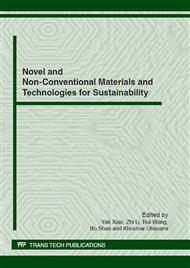[1]
JUDZIEWICZ, E. J.; CLARK, L. G.; LONDOÑO, X.; STERN, M. J. American bamboos. Washington/DC, Smithsonian Institution Press, (1999).
Google Scholar
[2]
OHRNBERGER, D. The Bamboos of the World. Elsevier Science, (1999).
Google Scholar
[3]
KUMAR, M. Field identification key to native bamboos of Kerala. Kerala Forest Research Institute, (2002).
Google Scholar
[4]
LIESE, W.; KUMAR, S. Bamboo preservation compendium. Centre for Indian Bamboo Resource and Technology, New Delhi, (2003).
Google Scholar
[5]
GHAVAMI, K.; MARINHO, A. B. Determinação das propriedades dos bambus das espécies: Guadua angustifólia, Guadua tagoara e Dencrocalamus giganteus para utilização na engenharia. Departamento de Engenharia Civil, Pontifícia Universidade Católica do Rio de Janeiro. (2001).
DOI: 10.17771/pucrio.acad.7946
Google Scholar
[6]
BERALDO, A. L.; AZZINI, A.; GHAVAMI, K.; PEREIRA, M. A. R. BAMBU: CARACTERÍSTICAS E APLICAÇÕES In: Tecnologias e Materiais Alternativos de Construções. FREIRE, W. J.; BERALDO, A. L. Campinas: Editora UNICAMP, 2003. (Capítulo IX, pp.253-298).
Google Scholar
[7]
BERALDO, A. L., RIVERO, L. A. Bambu Laminado Colado. Floresta e Ambiente, 10, pp.36-43, (2003).
Google Scholar
[8]
KAHLER, C. G. Global Bamboo Thematic Study and Workshop. 2005. Beijing. Report on Bamboo Thematic Study in Framework of FAO FRA 2005 for Latin America. Rome, 2006: Working Paper 123.
Google Scholar
[9]
RODRÍGUEZ, L. M.; LONGHI, M. M. Efecto de la edad y la posición de las yemas en el culmo, en la reproducción vegetativa de Bambusa vulgaris y Giagantochloa apus. Revista de Biología Tropical, 46, pp.28-35, (1998).
DOI: 10.4067/s0718-19572011000200020
Google Scholar
[10]
GOMIDE, J. L.; COLODETTE, L. J.; OLIVEIRA de, R. C. Estudos das potencialidades do Bambusa vulgaris para produção de papéis tipo Kraft. O Papel, 28, pp.38-42, (1982).
Google Scholar
[11]
BISWAS, S. Bamboo biodiversity in Índia. Forest Research Institute, Indian Council of Forestry Research and Education. VII WORLD BAMBOO CONGRESS. New Delhi, Feb. /Mar., (2004).
Google Scholar
[12]
SILVEIRA, M. Ecological aspects of bamboo-dominated forest in southwestern Amazonia: an ethnoscience perspective. Ecotropica, 5, pp.213-216, (1999).
Google Scholar
[13]
TERRA, G. R. A. Aspectos da história de vida de Guadua tagoara (Nees) Kunth (Poaceae: Bambuseae) na Serra dos Órgãos, RJ. 2007. Dissertação (Mestrado em Ecologia) -Programa de Pós Graduação em Ecologia e Recursos Naturais, Universidade Federal de São Carlos, SP.
DOI: 10.18605/2175-7275/cereus.v9n3p66-80
Google Scholar
[14]
Available at: <http: /www. anba. com. br/noticiaagronegocios. kmf?cod=7426502& indice=630>. Access in: 15 Apr. (2011).
Google Scholar
[15]
LONGHI, M. M.; RODRÍGUEZ, L. M. Historia ecológica y aprovechamiento del bambú. Revista de Biología Tropical, 46, pp.11-18, (1998).
Google Scholar
[16]
MONTES, L. F.; LONGHI, M. M.; QUINTANA, M. M.; Propagación y desarrolo de quatro variedades de bambu en condiciones de campo. Revista de Biología Tropical, 46, pp.36-40, (1998).
Google Scholar
[17]
TARGA, M. S. Determinação de parâmetros hidráulicos e avaliação econômica de tubos de bambu-gigante (Dendrocalamus giganteus), para utilização em drenagem. 1997. 173f. Tese (Doutorado em Agronomia) - Escola Superior de Agricultura Luiz de Queiroz, Piracicaba, (1997).
DOI: 10.11606/t.11.1997.tde-20210104-184719
Google Scholar
[18]
SCURLOCK, J.; DAYTON, D.; HAMES, B. Bamboo: an overlooked biomass resource? Biomass and Bioenergy, 19, pp.229-244, (2000).
DOI: 10.1016/s0961-9534(00)00038-6
Google Scholar
[19]
SIMIONI, F. J. Análise diagnóstica e prospectiva da cadeia produtiva de energia de biomassa de origem florestal. 2007. 141f. Tese (Doutorado em Engenharia Florestal na área de concentração em Economia e política Florestal) - Programa de Pós Graduação de Engenharia Florestal, Universidade Federal do Paraná, Curtiba.
DOI: 10.12953/2177-6830/rcm.v8n2p54-63
Google Scholar
[20]
EL BASSAM, N.; MEIER, D.; GERDES, C.; KORTE, A. Potential of producing biofuels from bamboo. In: KUMAR, A.; RAMANUJA; RAO, I. V.; SASTRY, C. (eds. ). Bamboo for sustainable development, 2002, pp.797-806.
DOI: 10.1163/9789004473911_077
Google Scholar
[21]
TEMMERMAN, M.; VAN BELLE, J.; DELCARTE, J.; GIELIS, J.; BRIAS, V. Bamboo thematic network: Bamboo as a source of bioenergy. Technical paper, CRAW Walloon Agricultural Research Center & Oprins Plant NV. VIII World Bamboo Congress Proceedings v. 3, 32, (2005).
Google Scholar
[22]
BRITO, J. O.; TOMAZELLO FILHO, M.; SALGADO, A. L. B. Produção e caracterização do carvão vegetal de espécies e variedades de bambu. IPEF, n. 36, pp.13-17, (1987).
Google Scholar
[23]
RIBEIRO, A. S. Carvão de bambu como fonte energética e outras aplicações. Maceió: Instituto do Bambu, (2005).
Google Scholar
[24]
PRESZNHUK, R. A. O. Estudo da viabilidade do filtro de carvão de bambu como pós-tratamento em estação de tratamento de esgoto por zona de raízes: tecnologia ambiental e socialmente adequada. 2004. 110f. Dissertação (Mestrado em Teconologia) - Pós-Graduação em Tecnologia, Centro Federal de Educação e Tecnologia do Paraná.
DOI: 10.5902/223611704375
Google Scholar
[25]
SALGADO, A. L. B.; AZZINI, A.; CIARAMELLO, D.; MACEDO, E. L.; SALGADO, A. L. Instruções técnicas sobre o bambu. Boletim técnico. Instituto Agronômico de Campinas, Campinas, SP, Maio (1994).
Google Scholar
[26]
Available at: <http: /www. sbrt. ibict. br>. Access in: 15 Apr. (2011).
Google Scholar
[27]
GHAVAMI, K. Bambu: Um material alternativo na Engenharia. Engenharia - Revista do Instituto de Engenharia, 492, pp.2-7, (1992).
Google Scholar
[28]
AZZINI, A.; SANTOS, R. L.; PETTINELI JÚNIOR, A. Bambu: material alternativo para construções rurais. Boletim técnico, 171, Campinas, Instituto Agronômico, (1997).
Google Scholar
[29]
KOGA, R. C. BITTENCOUR, R. M. GONÇALVES, M. T. T. Resistência à abrasão do bambu gigante e espécies de madeiras para utilização como elemento piso. VII ENCONTRO BRASILEIRO EM MADEIRAS E EM ESTRUTURAS DE MADEIRA. Uberlândia – M.G. Anais. Julho de (2002).
DOI: 10.12953/2177-6830/rcm.v10n2p135-141
Google Scholar
[30]
TEIXEIRA, A. A. Painéis de bambu para habitações econômicas: avaliação do desempenho de painéis revestidos com argamassa. 2006. Dissertação (Mestrado em Desenho Industrial) - Pós Graduação em Arquitetura e Urbanismo, Universidade de Brasília.
DOI: 10.17127/got/2021.22.002
Google Scholar
[31]
DANTAS, A. B. et al. O uso do bambu na construção do desenvolvimento sustentável. Maceió: Instituto do Bambu. (2005).
DOI: 10.29327/iii_sustentare_vi_wipis.440650
Google Scholar
[32]
CALEGARI, L.; HASELEIN, C. R.; SCARAVELLI, T. L.; SANTINI, E. J.; STANGERLIN, D. M.; GATTO, D. A.; TREVISAN, R. Desempenho físico–mecânico de papéis fabricados com bambú Bambusa vulgaris. em combinação com madeira. Cerne, 13, pp.57-63, (2007).
DOI: 10.5902/1980509810859
Google Scholar
[33]
FILGUEIRAS, T. S.; GONÇALVES, Bambus nativos do Distrito Federal, Brasil (Gramineae: Bambusoideae). Revista Brasileira de Botânica, 11, pp.47-66, (1988).
Google Scholar


